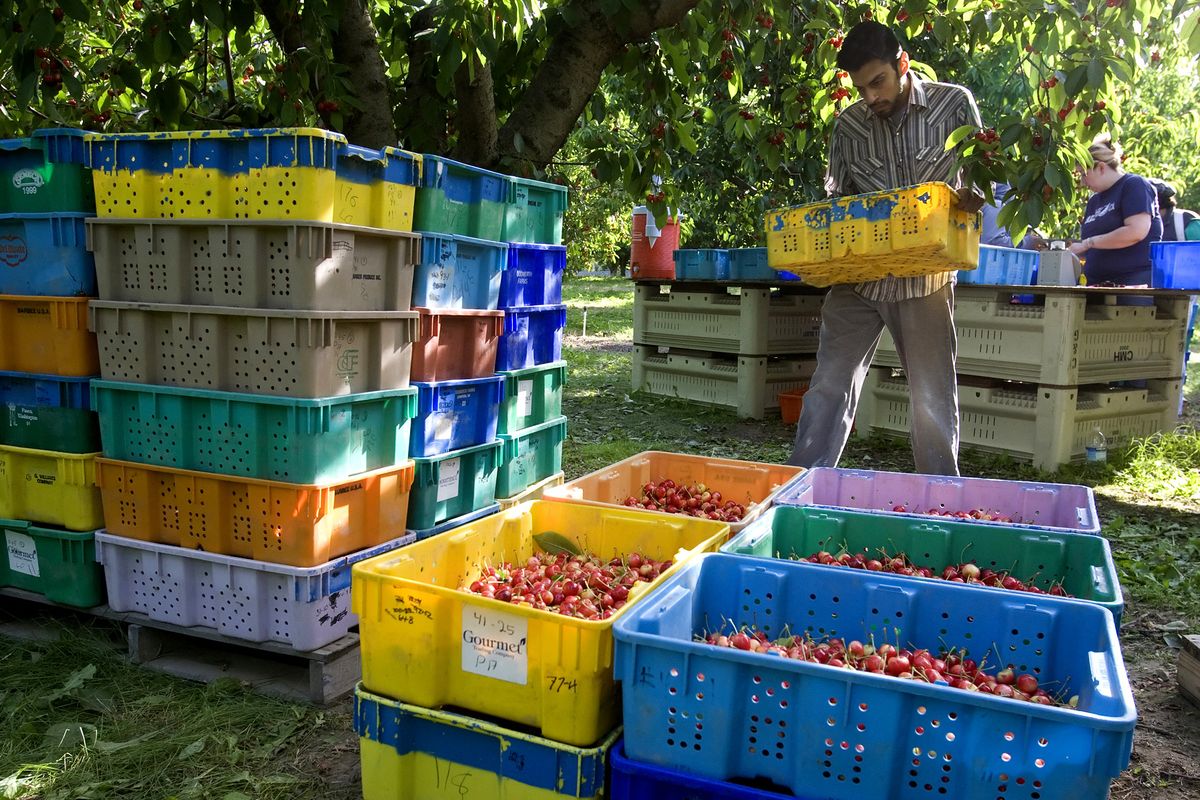Cherries finally ready to harvest

YAKIMA – In the early morning shade of Don Olmstead Jr.’s orchard, workers scurry to and from a weighing table with buckets of pink-and-yellow Rainier cherries.
And it’s about time, Olmstead said. “This is the latest cherry crop we’ve ever had,” he said.
Roughly two weeks behind schedule, Yakima Valley cherry growers started picking fruit this week. Some might even make it to market for the Fourth of July weekend, traditionally an important one for the crop.
“We’re finally rocking and rolling,” said B.J. Thurlby, director of the Northwest Cherry Growers Association.
The Fourth of July is the No. 1 fresh produce sales holiday of the year, especially for the iconic summer cherries – a $573 million crop for the Northwest.
But this year is producing an oft-repeated story: The cool, damp spring pushed everything back. Melons, peach and corn are late this year, too, Thurlby said. Asparagus harvest didn’t start until the end of April.
Tri-Cities and Mattawa cherry growers began harvesting roughly a week ago, giving them their usual head start. Yakima Valley growers are just hitting stride this week, and area packing houses have been running two shifts for the first time this year, Thurlby said.
Washington, Oregon, Idaho, Montana and Utah ship about 14 million boxes each season. Washington accounts for about 80 percent of the shipments.
Usually, growers pick between 5 million and 7 million boxes by the end of June. This year, they will reach 2 million at most, Thurlby predicted.
Some of their produce picked Tuesday may hit store shelves along the West Coast by the Fourth, Thurlby said. After that, growers must hope for an extended summer of picnics and backyard cookouts.
“We’re hoping we catch the wave of summer,” Thurlby said.
The climate gave Yakima Valley growers one break, however: California had late-harvest rain damage, costing 3 million to 4 million boxes, Thurlby said.
That left markets with a vacuum to fill. Retailers all over the globe have been anxiously awaiting cherries.
“They want every cherry they can get their hands on,” said Gene Gifford, general manager of Conrad and Adams Fruit LLC packing warehouse in Grandview.
About 30 percent of the Northwest’s cherries – 4 million boxes – are exported, accounting for $178 million in sales. Most of those exported cherries head to Asian markets, with China the largest.
The warehouse started full-swing operation this week, putting 300 anxious temporary employees to work.
“By the end of the week, they’ll get all the hours they need,” Gifford said.
Industry and labor officials have not heard of any labor shortages. The California rain damage may have pushed more workers into the state, said Mike Gempler, executive director of the Washington Growers League of Yakima.
Mark Barrett, a Yakima cherry grower, will have only a few of his own early varieties – Chelan and Tieton – for his fruit stand on Pecks Canyon Road in time for the Fourth.
Barrett has brought in cherries from a Mattawa ranch to fill out his bins for his family’s Saturday cherry festival.
He won’t pick his dark red Bings until July 6 and estimates his harvest is between seven and 10 days later than normal, though cherries are such a sensitive crop it seems like something throws them off nearly ever year, he said.
“I don’t know what’s normal anymore,” Barrett said. “It seems like every year is not normal anymore.”
Olmstead, 63, president of Olmstead Orchards, agreed: No two cherry seasons are alike.
But neither he nor his father, Don Olmstead Sr., 94, remember a harvest this late. They have been growing cherries on the slopes south of Grandview for decades. Some of their trees are 60 years old.
Normally, their workers would have cleaned out some of their blocks by the Fourth. Occasionally, they even take the holiday off.
Not this year. Everybody plans to harvest right through Independence Day.
The family’s Olmstead Orchards business began picking Sunday, hiring roughly 160 temporary employees to pluck Rainiers, which ripened before the dark red Bings this year – another unusual development.
Olmstead speculated that his particular Rainier block has an unusually healthy sun exposure working in his favor this year.
Or it’s just one more fluke. “Everything about this year is kind of goofy,” he said.